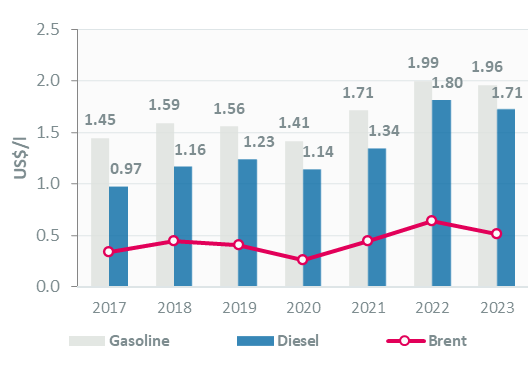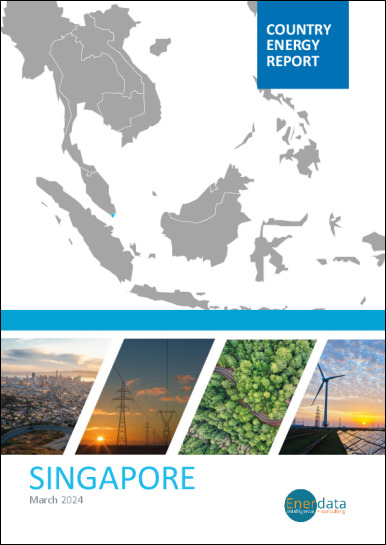- Update
-
- Format
- 3 files (PDF report, 2 Excel files)
- Pages
-
30 (Report only)
- Delivery
- Immediate by e-mail
- GENERAL OVERVIEW
- INSTITUTIONS AND ENERGY POLICY
- ENERGY COMPANIES
- ENERGY SUPPLY
- ENERGY PRICES
- ENERGY CONSUMPTION
- ISSUES AND PROSPECTS
- DATA TABLES
- ABBREVIATIONS
- GLOSSARY
Buy Singapore energy report
Price without VAT. Depending on your statute and location, VAT might be applicable. Get in touch with us for more information.
After validation, you will immediately receive 3 files by email (one pdf report and 2 excel files containing the datasets).
Overview
This analysis includes a comprehensive Singapore energy market report and updated datasets. It is derived from the most recent key economic indicators, supply and demand factors, oil and gas pricing trends and major energy issues and developments surrounding the energy industry. The report provides a complete picture of the country situation, dynamics, current issues and future prospects. With market data and continuous follow-up of markets news, this report brings clear and concise insights with which to tackle national energy challenges and opportunities. Browse the tabs below for a detailed table of contents, the list of graphs and tables, and details on the data files.
Highlights
- Singapore has already reached its NDC target of a 35% reduction in the GHG emission intensity compared to 2005.
- The government targets 2 GW of solar PV and to capture 2 MtCO2/year via CCUS by 2030.
- Tuas Power, YTL PowerSeraya, and Senoko Energy are the main power generators, with around half of the power mix.
- ExxonMobil and Shell dominate refining.
- Pavillon Gas and SembCorp account for 70% of the gas retail market (2022).
- Singapore is a major oil hub in Asia and the world's third largest oil trading place.
- Natural gas accounts for 92% of the power mix (2024).
- Gasoline and electricity prices for households are around 3 times higher than in Malaysia and Indonesia.
- Oil covers 70% of the country's total consumption, but its share has been decreasing at the expense of gas.
- Industry and non-energy uses absorb 71% of the final energy consumption.
- Electricity demand is expected to grow by around 3%/year by 2028.
- The country plans to import over 6 GW of low-carbon electricity by 2035 from Indonesia, Australia, Vietnam, and Cambodia.
Institutions & Energy Policy
The energy sector is controlled by the Energy Division (ED) of the Ministry of Trade and Industry. The Energy Division lays down the sector's strategic policy and the country's energy policy. The policy goals are to ensure economic growth, energy security, competitiveness, and sustainable development.
Energy Companies
Electricity:
In 2023, the three historical power producers represented 59% of the total generation capacity and 52% of the country's power mix: Tuas Power (2.8 GW, 23% of the capacity and 20% of the power mix), YTLPowerSeraya (2.4 GW, 19% and 15%, respectively), and Senoko Energy (2 GW, 16% and 17%, respectively).
Energy Supply
Gas:
Singapore imports natural gas through three gas pipes and one LNG regasification terminal. One 4 km cross-border gas pipe links the country to Malaysia. The second pipeline is the 654 km West Natuna Transportation System pipe, which connects the gas fields of West Natuna in Indonesia to the industrial area of Jurong Island.
Energy Prices
Oil:
The price of premium gasoline decreased by 3.5% in 2024 to US$1.90/l, while diesel prices remained stable at US$1.72/l. These prices follow international prices and are much higher than in Malaysia or Indonesia.
Graph: GASOLINE & DIESEL PRICES (US$/l)

Energy Consumption
Total energy consumption per capita is about 6.4 toe (2024), i.e., 4 times more than the Asian average, with a consumption of 9 822 kWh of electricity (3 times the Asian average).
Issues & Prospects
In 2014, the National Climate Change Secretariat (NCCS) released five technology roadmaps to guide the nation in preparing its energy future. The five roadmaps are - Solar Photovoltaic, Carbon Capture and Storage, Green Data Centre, Building Energy Efficiency, and Industrial Energy Efficiency.
- GRAPH 1: CO2-energy Emissions (MtCO2)
- GRAPH 2: Installed electric capacity by source (2024, %)
- GRAPH 3: Gross power production by source (TWh)
- GRAPH 4: Power generation by source (2024, %)
- GRAPH 5: Gasoline & diesel prices (US$/l)
- GRAPH 6: Electricity prices for industry and households (US$c/kWh)
- GRAPH 7: Gas prices for industry and households (US$c/kWh GCV)
- GRAPH 8: Consumption Trends by energy source (Mtoe)
- GRAPH 9: Total consumption market share by energy (2024, %)
- GRAPH 10: Final consumption market share by sector (2024, %)
- Economic Indicators: Annual historical data including population, GDP growth, imports and exports, inflation rate, energy security and efficiency indicators, CO2 emissions.
- Supply Indicators: Historical data including oil and gas reserves, electric and refining capacity, energy production, power production and external trade. All are detailed by energy source.
- Demand Indicators: Historical data including consumption per inhabitant, consumption trends, total consumption by energy source, final consumption by energy source and sector, and electricity consumption by sector.
- Energy Balances: Single table displaying the overall energy industry balance per annum, also graphically displayed by energy sub-segment.
- Infrastructure Projects: Covers power plant projects by energy, technology, status and operator.
The Singapore energy market data since 1990 and up to
is included in the Excel file accompanying the Singapore country report.
It showcases the historical evolution, allowing users to easily work with the data.
Key Data included in the excelsheet:
- Economic indicators: Annual historical economic indicators, energy security, energy efficiency and CO2 emissions.
- Supply indicators: Annual historical reserves, capacity, production and external trade (imports(+) exports(-) balance).
- Demand indicators: Annual historical consumption per capita, consumption trends, total consumption, final consumption (per energy and per sector) and electricity consumption total and per sector.
- Energy Balance: total and per energy.
- Singapore Energy Prices: In addition to the analysis provided on the report we also provided a data set which includes historical details on the Singapore energy prices for the follow items: price of premium gasoline (taxes incl.), price of diesel (taxes incl.), price of electricity in industry (taxes incl.), price of electricity for households (taxes incl.), price of natural gas in industry (taxes incl.), prices of natural gas for households (taxes incl.), spot price of Brent and CO2 emissions (from fuel combustion).
 Energy and Climate Databases
Energy and Climate Databases Market Analysis
Market Analysis